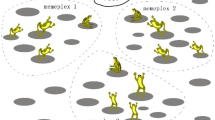Abstract
Shuffled frog leaping (SFL) algorithm is a recently introduced metaheuristic which mimics the foraging process of frogs. SFL performs exploration as well as exploitation. In SFL algorithm the colony of frogs is divided into several memeplexes. In each memeplexes frog perform independent social cooperative local search and in later stages this information is shared among memeplexes. The process of sharing the information is shuffling process. SFL has been successfully applied to solve various real world optimization problems. In the present study SFL algorithm is implemented on a very interesting and challenging issue of optimization of Air pollution emissions using different control technologies. The nature of the problem is mixed integer linear programming problem. To further validate the efficacy of the algorithm shipping problem is also solved. The simulated results demonstrate the effectiveness of SFL algorithm.




Similar content being viewed by others
References
Amirian H, Sahraeian R (2017) Solving a grey project selection scheduling using a simulated shuffled frog leaping algorithm. Comput Ind Eng 107:141–149
Calvert S, Englund HM (1984) Handbook of air pollution technology. Wiley, New York
Dash R (2017) An improved shuffled frog leaping algorithm based evolutionary framework for currency exchange rate prediction. Physica A 486:782–796
Deb K (2000) An efficient constraint handling method for genetic algorithms. Comput Method Appl Mech Eng 186(2):311–338
Douglas JM (1992) Process susnthesis fro waste minimization. Ind Eng Chem Res 31:238–243
Duan X, Niu T, Huang Q (2018) An improved shuffled frog leaping algorithm and its application in dynamic emergency vehicle dispatching. Math Probl Eng Article ID 7896926. https://doi.org/10.1155/2018/7896926
Eusuff MM, Lansey KE (2003) Optimization of water distribution network design using the shuffled frog leaping algorithm. J Water Resour Plan Manag 129(3):210–225
Eusuff MM, Lansey KE, Pasha F (2006) Shuffled frog-leaping algorithm: a memetic metaheuristic for discrete optimization. Eng Optim 38(2):129–154
Fanian F, Rafsanjani MK (2018) Memetic fuzzy clustering protocol for wireless sensor networks: shuffled frog leaping algorithm. Appl Soft Comput 71:568–590
Fonyo Z, Kurum S, Rippin DWT (1994) Process development for waste minimization: the retrofitting problem. Comput Chem Eng 18(Suppl.):s581–s595
Gupta P, Mehrotra D, Sharma TK (2016) Role of decision tree in supplementing tacit knowledge for hypothetico-deduction in higher education. Int J Syst Assur Eng Manag 9(1):82–90
Janani S, Ramyachitra D, Ranjani Rani R (2018) PCD-DPPI: protein complex detection from dynamic PPI using shuffled frog-leaping algorithm. Gene Rep 12:89–98
Jun W, Yuelin G, Lina Y (2013) An improved differential evolution algorithm for mixed integer programming problems. In Ninth international conference on computational intelligence and security. https://doi.org/10.1109/cis.2013.14
Kaur P, Mehta S (2017) Resource provisioning and work flow scheduling in clouds using augmented Shuffled Frog Leaping Algorithm. J Parallel Distrib Comput 101:41–50
Li W, Cao J, Wu J, Huang C, Buyya R (2018) A collaborative filtering recommendation method based on discrete quantum-inspired shuffled frog leaping algorithms in social networks. Future Gener Comput Syst 88:262–270
Liang J, Runarsson TP, Mezura-Montes E, Clerc M, Suganthan P, Coello CC, Deb K (2006) Problem definitions and evaluation criteria for the CEC 2006 special session on constrained real-parameter optimization. J Appl Mech 41:1–8
Pérez-Delgado María-Luisa (2019) Color image quantization using the shuffled-frog leaping algorithm. Eng Appl Artif Intell 79:142–158
Rajpurohit J, Sharma TK, Abraham A, Vaishali (2017) Glossary of metaheuristic algorithms. Int J Comput Inf Syst Ind Manag Appl 9:181–205
Shaban HI, Elkamel A, Gharbi R (1997) An optimization model for air pollution control decision making. Environ Model Softw 12(1):51–58
Sharma TK (2018) Estimating software reliability growth model parameters using opposition-based shuffled frog-leaping algorithm. In: Ray K et al (eds) Soft computing applications. Springer, Berlin, pp 149–164
Sharma TK, Pant M (2016) Identification of noise in multi noise plant using enhanced version of shuffled frog leaping algorithm. Int J Syst Assur Eng Manag 9(1):43–51
Sharma TK, Pant M (2017) Distribution in the placement of food in artificial bee colony based on changing factor. Int J Syst Assur Eng Manag 8(1):159–172
Tripathy B, Dash S, Padhy SK (2015) Multiprocessor scheduling and neural network training methods using shuffled frog-leaping algorithm. Comput Ind Eng 80:154–158
Author information
Authors and Affiliations
Corresponding author
Additional information
Publisher's Note
Springer Nature remains neutral with regard to jurisdictional claims in published maps and institutional affiliations.
Rights and permissions
About this article
Cite this article
Sharma, T.K., Prakash, D. Air pollution emissions control using shuffled frog leaping algorithm. Int J Syst Assur Eng Manag 11, 332–339 (2020). https://doi.org/10.1007/s13198-019-00860-3
Received:
Revised:
Published:
Issue Date:
DOI: https://doi.org/10.1007/s13198-019-00860-3




